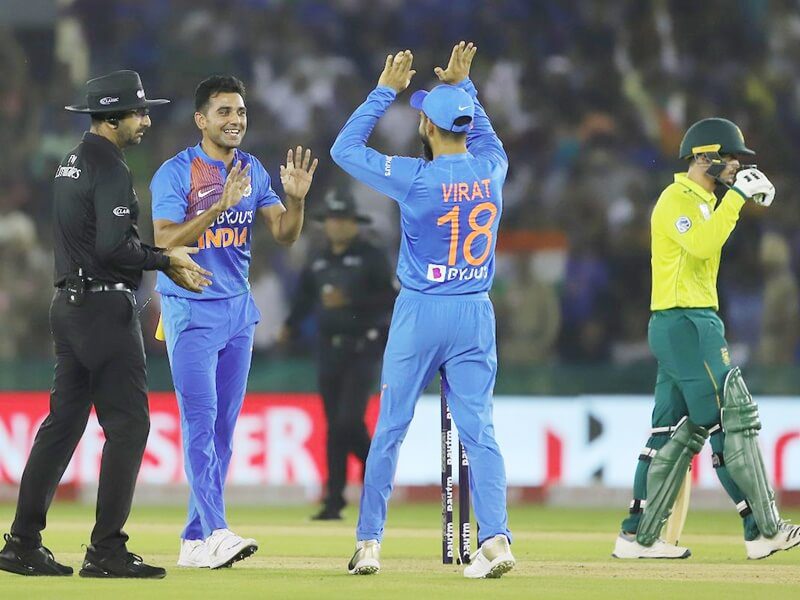Reading Time: 5 minutes
In the recently concluded T-20 series between India and South Africa, both teams won a game apiece and the series was levelled 1-1. Though it is early to comment on the fruits borne by the change in approach towards T-20, it looks like an interesting year for Indian T-20 squad. A report by Vijayhardik, exclusively for Different Truths.
 Before the home season got underway, there was a lot of chatter. This season began with the T-20s. A departure from a more tradition template, where the ODIs or Tests would have marked the beginning of a new season. However, with a view on the upcoming ICC events in the international cricket calendar, there was a change in approach.
Before the home season got underway, there was a lot of chatter. This season began with the T-20s. A departure from a more tradition template, where the ODIs or Tests would have marked the beginning of a new season. However, with a view on the upcoming ICC events in the international cricket calendar, there was a change in approach.
Before the series began there was a buzz in the cricketing circles about the Indian T-20 policy. Considered to be an extension of the ODI format, the same set of players were retained to form squads for both the formats.
On the current South African tour of India, the T-20s were the opening act. Before the series began there was a buzz in the cricketing circles about the Indian T-20 policy. Considered to be an extension of the ODI format, the same set of players were retained to form squads for both the formats.
Recognising that the approach of looking at the T-20 version as an extension was not yielding results. A change in approach has been signaled. The selection of the squad which includes T-20 specialist utility players reflects the shift.
In the recently concluded T-20 series against South Africa, there were glimpses of the changed policy.
In the recently concluded T-20 series against South Africa, there were glimpses of the changed policy. After the first game of the series at Dharamshala was washed out due to rain, the series virtually was reduced to a two-match series.
When the teams got down to business at Mohali, the team selection showed that Team India had walked the talk. Inclusion of T-20 specialists like Krunal Pandya, Washington Sundar, Ravindra Jadeja and giving Rishabh Pant more chances to cement his place in the team reflected the new style of functioning in the T-20s.
At Mohali, India after calling the coin correctly decided to field. This was India playing to their strengths.
At Mohali, India after calling the coin correctly decided to field. This was India playing to their strengths. While chasing down totals, the Indian batting unit looks a well-oiled machine that knows how to get the job done. It is setting up totals where the batting line up falters at regular intervals. 
Making first use of the pitch before the dew set in was a good decision. In conditions conducive for bowling (in reference to T-20 standards), the Indian bowlers made a decent start. While the Proteas skipper and experienced T-20 campaigner Quinton de Kock was dominating the bowling, his partner Hendricks was put out of his misery after a 11-ball 6.
De Kock in company of Bavuma built a partnership that could have changed the course of the game. But the fall of de Kock after his half-century doused those plans.
De Kock in company of Bavuma built a partnership that could have changed the course of the game. But the fall of de Kock after his half-century doused those plans. With many players on their first tour of India and Miller being a spent force could not force the issue on a two paced pitch. A couple of big hits in the final over off Saini took the score to a fighting 149 at the end of their innings.
In response, India came out all guns blazing as Rohit Sharma hit South Africa quick Nortje for a couple of sixes inside the powerplay. This was in stark contrast to the conservative approach of the Indian batsmen where they looked to save wickets inside the powerplay. Now there were taking the fight to the opposition. Though Rohit Sharma perished soon, he had done his job. He gave India a good quick launchpad to build their chase on.
His departure brought the Master of the Chase Virat Kohli to the crease. Joining Dhawan who seemed to have regained his mojo, they kept the scoreboard motoring.
His departure brought the Master of the Chase Virat Kohli to the crease. Joining Dhawan who seemed to have regained his mojo, they kept the scoreboard motoring. Sending the ball to the fence at frequent intervals was taking the match away from South Africa. Dhawan playing his expansive strokes had his innings cut short due to a brilliant piece of fielding by Miller at long-on.
This found Kohli in a familiar space. He was there in the thick of action to take control of the chase. And he did what he does best with aplomb. Virat Kohli scored another half-century in a T-20 chase and remained unbeaten till the winning runs were scored. India registered a 7 wicket win over South Africa.
Round one went to India.
The series moved down south to the IPL home ground of Indian skipper Virat Kohli, the Chinnaswamy Stadium.
The series moved down south to the IPL home ground of Indian skipper Virat Kohli, the Chinnaswamy Stadium. Its dossier shows that the teams have never chosen to bat after winning the toss in the previous 6 matches. But Kohli decided to bat first after winning the toss.
Though the scorecard reflects otherwise, India did manage to get off to a decent start. Scoring 63 for the loss of two wickets at the end of the eighth over was a good enough platform. But the bug of a random collapse bit the Indian batting line-up. With the dew not a factor yet, the bowlers had enough in the pitch for them to try their tricks.
With the batsmen failing to apply themselves in accordance with the pitch conditions saw them throw away their wickets. The middle order once again stuck out like a sore thumb.
With the batsmen failing to apply themselves in accordance with the pitch conditions saw them throw away their wickets. The middle order once again stuck out like a sore thumb. Some contribution from Ravindra Jadeja and Hardik Pandya down the order saw India scrape through to 134/9.
The chase was similar to the previous match albeit with the tables turned. It was South Africa chasing a modest target of 135 to level the series. With the second rung of bowlers bleeding runs at alarming rates did not see pressure build up on the Proteas. By the time India prized out the wicket of Hendricks, South Africa had overhauled more than half the target.
With conditions tailor made for Quinton de Kock’s style of batting and armed with the experience of playing for the Royal Challengers Bangalore he went about scoring runs at a blistering pace.
With conditions tailor made for Quinton de Kock’s style of batting and armed with the experience of playing for the Royal Challengers Bangalore he went about scoring runs at a blistering pace. He brought out his favourite shots the drive over covers and slap on the leg side that sets ball sailing high into crowds. He scored a second consecutive fifty in two matches. While the previous one came in a losing cause, this time he guided his team to a 9 -wicket victory.
The victory brought South Africa on level with India and the Proteas drew the series 1-1.
Photos sourced by the author from the Internet














